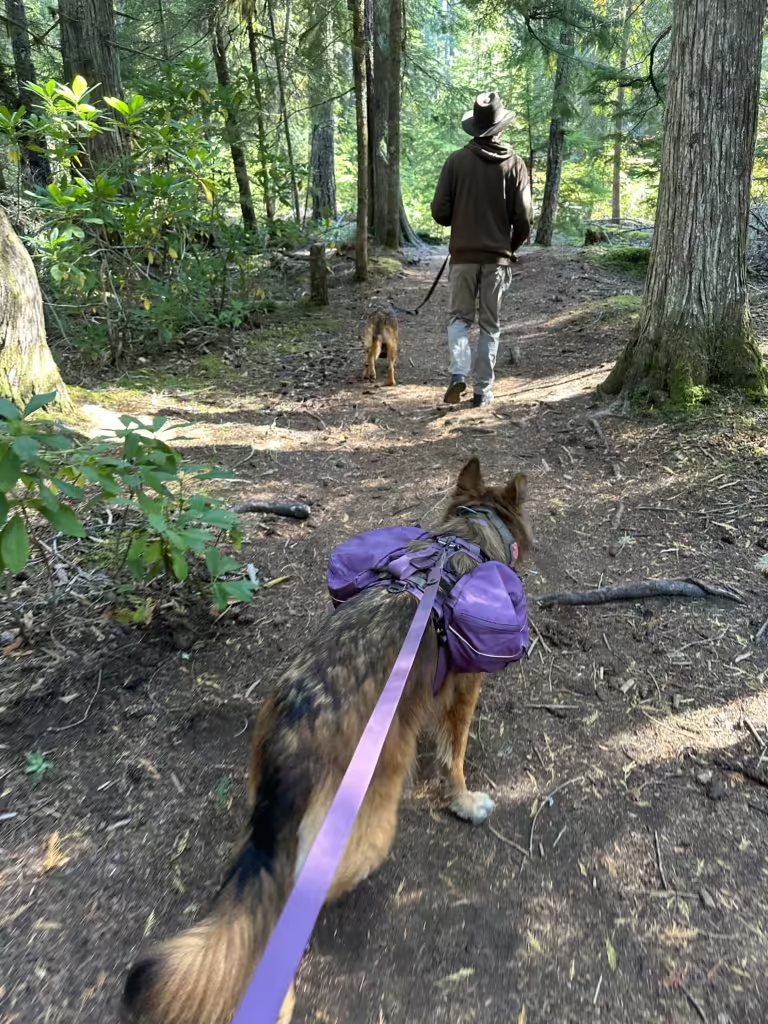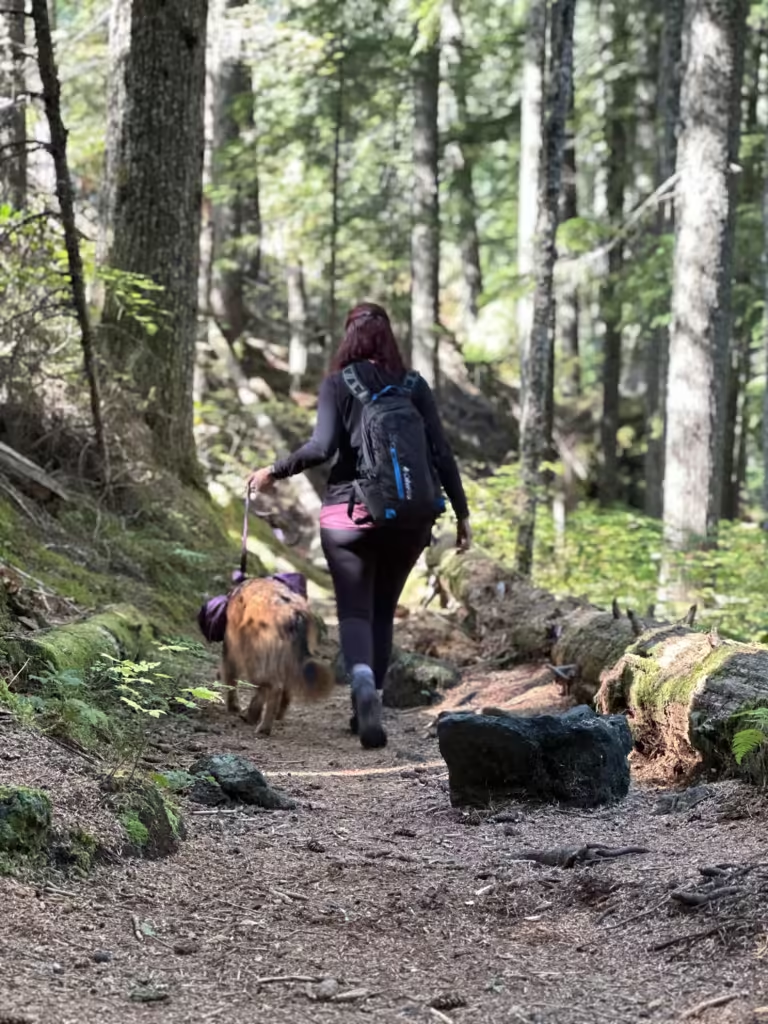Training a Trail Dog: Teach Your Dog to Become the Ultimate Trail Companion
Training a trail dog is an adventure that can strengthen the bond between you and your pup. It’s about developing a mutual understanding and trust that goes beyond the backyard into the dynamic environments of the great outdoors.
I started taking my dog Piper on the trails when she was a puppy, and it has not only enriched our daily routines but also added joy and energy to our excursions.
Safety, of course, is a top priority, and the learning process requires patience and consistency, but the rewards are incredibly fulfilling.
From the moment you start with the basics to more advanced commands, every step brings you closer to having a reliable and happy trail companion.

Building this companionship means committing to basic obedience and safety on the trail.
We started with the easier commands like ‘sit,’ ‘stay,’ ‘place,’ and ‘come.’ Then, we added duration for each command until she could hold each command for longer periods. As we progressed, we trained a strong recall using a long line and high-value treats, which has been invaluable. My trusty trail dog can navigate the distractions of nature and return to me with just a call.
Making sure my dog stays healthy and safe during our adventures has always been important; this means knowing what to do in case of injury or exhaustion and understanding my dog’s limits.
Your training time is also about cultivating joy and trust, creating a positive learning environment that makes every training session something to look forward to. I always tried to make training fun for my dog, which has greatly impacted our relationship.
Key Takeaways
- Training your trail dog requires patience and time, starting with essential commands for safety and cooperation.
- A reliable recall is crucial for off-leash trail adventures, ensuring your dog’s safety amidst distractions.
- Prioritizing your dog’s well-being enhances the trail experience for both of you, making each outing enjoyable.
Table of Contents
Getting Started with Trail Dog Training
Training your trail dog can be one of the most rewarding experiences. It’s about building a bond and ensuring safety and fun on the trails.
Let’s break it down into understanding your dog’s needs and gearing up for those awesome adventures!
Understanding Your Dog’s Breed and Behavioral Needs
Every pup has its own quirks, and knowing your dog’s breed characteristics is super handy.
Some breeds, like Border Collies and Labradors, have energy pouring out of their ears and can take on longer trails, while others might prefer a casual stroll. Here’s the scoop:
- Energy Levels: Match training intensity with your dog’s natural stamina.
- Behavioral Traits: Understand your breed and use breed-specific traits to your advantage – herding dogs might excel at following trails, for example.
- Training Progression: Start with basic commands and then gradually introduce more complex tasks.
If you have a mixed breed, it’s still possible to understand their potential breed characteristics. Here are some tips:
- Look at physical traits: Examine your dog’s appearance, such as size, build, coat type, and facial features. These can provide clues about the breeds in their makeup.
- Consider behavior: Certain breed tendencies can influence a dog’s personality, energy level, and behavior. Observe your dog’s temperament and activities they seem drawn towards.
- Get a DNA test: Dog DNA tests analyze your pet’s genetic makeup and can identify the breeds that contributed to their heritage. This gives you insight into potential traits.
- Research breeds: Once you have an idea of potential breed mixes, read about the typical characteristics of those breeds in terms of size, energy, grooming needs, trainability, etc.
- Talk to your vet: Your veterinarian may be able to examine your dog and make an educated guess about possible breed mixes based on their expertise.
- Consider their background: If you know anything about your dog’s parents or where they came from, this context can provide helpful clues.
The key is using multiple data points like appearance, behavior, DNA and background information to piece together the breeds that make up your mixed pup’s heritage. This can help set realistic expectations for their exercise needs and personality traits.
No matter your pup’s background, training doesn’t happen overnight. Like learning to flip pancakes without making a mess, patience is key.
I always watch out for signs of tiredness or frustration and keep things light and positive. It’s my goal to end every adventure on a positive note and I try to make sure my dog is happy and feeling good.
PIN IT FOR LATER!
Essential Gear for Trail Adventures
Now, onto the fun part – gear! Here’s a quick rundown of the must-haves:
- Leash: A sturdy, comfortable leash keeps your trail buddy safe and secure.
- Hydration Pack: Dogs need to slurp water just like us, so a doggy hydration pack can be a lifesaver on long treks.
Here’s how I see it: the right gear ensures we can confidently tackle the trails. Plus, there’s nothing cuter than a pup with its own backpack.
Remember, ventilation for those fur coats is important, so breathable materials are a huge plus!
Basic Obedience and Command Training
Mastering a few key obedience commands will set the stage for a safe and happy hike with your dog, where everyone can enjoy the great outdoors without a hitch.

Mastering Basic Commands
Before even hitting the trail, I ensure my dog nails those basic commands like sit, stay, come, leave it, and heel.
It’s a bit like learning the ABCs before writing sentences.
For example, when I say, “Sit!”, I expect a prompt tush-on-the-ground action.
It’s a fundamental cue that can prevent my dog from chasing wildlife or approaching unwelcoming strangers.
- Stay: This one is my lifesaver when I need to pause and check my map.
- Come: Especially crucial when there’s potential danger, or it’s time to head back.
- Heel: Keeps my pup close by when the trail narrows or we encounter others. Not everybody enjoys being approached by dogs they don’t know so always be respectful and keep your dog close.
By keeping treat rewards handy and my voice cheerful, I try to make training sessions feel more like a fun game than a strict classroom. And keep them short, you’d be amazed what 5 minutes a few times a day can accomplish over time.
Leash Training and Loose Leash Walking
Teaching my dog loose leash walking was not negotiable for me. I don’t enjoy being drug down a trail by my dog! It took time and reps, but now she has it down and it has been worth the work.
The concept is simple—teach your pup to walk by my side without pulling on the leash, as if it’s barely there. This is essential when navigating uneven terrain or crossing streams.
- Leash: It’s their safety line and connection to me, so it mustn’t be a source of struggle.
- Heel (Loose Leash Style): It’s all about balance; not too tight, but not wandering off either.
I keep the leash slack enough for comfort but short enough for control. A treat when my dog looks at me reinforces that sticking close is worth their while.
Here’s a video I found really helpful when I was training my dog.
Instilling Trail Etiquette
The trail is for everyone, so I work on instilling trail etiquette in my canine companion.
Commands like “leave it” and “drop it” are super useful for teaching my dog not to disturb the environment or pick up things they shouldn’t.
- Leave It: Helps protect wildlife and keeps my dog from snacking on things that aren’t food-grade.
- Drop It: In case they do grab something, this ensures they’ll let go on command.
Ensuring my dog respects other hikers and leashed pets makes for harmonious trails and happy tails all around.
Building a Strong Recall
When training a trail dog, mastering recall commands is like holding the most valuable leash.
Trust me, you’ll want your furry friend to come prancing back with a wagging tail every time you call, no matter the distractions on the trail.
Training for Reliable Recall
First things first, we’ve got to keep our training sessions aromatic – and by aromatic, I mean filled with those high-value treats our pups go crazy for.
Starting off in a low-distraction, familiar environment is the golden ticket to laying down the groundwork.
I keep it simple, with clear and consistent commands: “Come!” or “Here!”—each one becoming music to my dog’s ears because amazing things happen when she comes back to me!
Practice Makes Perfect: Each day we spend a little time running through the basics. I start with calling my dog from a short distance and gradually increase the challenge.
Consistency is Key: Using the same recall command and sticking to the same routine cements the behavior. My dog knows when we’re in serious training mode, and I reward that with lots of praise and a game of tug.
Distance Control on the Trail
Now, onto the great outdoors—where the real magic happens.
I keep my commands short and sweet, ensuring they slice through all the background noise of the trail.
Distance Dynamics: Engaging in recall practice with increasing distances helps my trail dog understand that the command isn’t just for close quarters. From a few feet away to, eventually, across a field, we make sure the command is understood no matter the gap.
Distraction Handling: Let’s face it, squirrels, and interesting smells come a dime a dozen on a hike.
My tactic? I gradually incorporate common trail distractions into training sessions, always rewarding my pup for choosing my call over that tempting sniff. It’s all about staying more interesting than the environment. It took time, but consistent training has resulted in a rock-solid recall wherever I take my dog.
Safety and Health on the Trail

Keeping your furry friend safe and healthy while hiking is just as important as the adventure itself.
Let’s make sure that every trail trek with your dog is one for the ‘bark’ books by covering hydration, nutrition, rough terrains, encounters with wildlife, and soothing post-hike care.
Hydration and Nutrition for Your Trail Dog
Ensuring that my trail buddy stays hydrated and well-fed is my top priority.
I’ve seen dehydration sneak up on the best of us, so I always carry a collapsible bowl and a hydration pack specifically for dogs.
Whether you need to bring food for your pup or not will depend on the length of the trail. For long or multi-day hikes I opt for energy-rich foods that pack lightly but deliver big on nutrition. Here’s a quick checklist:
- Water: Ample for both of us, plus a bit extra.
- Food: High-protein doggy snacks or kibble.
Dealing with Terrain and Wildlife
The trail’s terrain can be a wild ride! One moment, we’re strolling along a babbling brook; the next, it’s an impromptu agility course.
I’ve taught my dog to follow commands to navigate tricky spots, especially when we encounter mountain bikers zooming by.
When it comes to wildlife, I keep my dog close – it’s respect for nature, and hey, no one wants a surprise encounter with a skunk.
Always keep a solid recall command in your dog’s skill set. Here are some tips:
- Keep your dog leashed or under firm voice control.
- Be aware of your surroundings and give wildlife space.
Post-Trail Dog Care and Massage
After our outdoor escapades, I turn into a doggy physiotherapist.
A good rubdown helps my dog relax and allows me to check for ticks or burrs.
It’s our ritual – a gentle paw massage, a belly rub, and a cozy rest. Here’s a simple after-hike checklist:
- Gently massage each paw and leg.
- Check for and remove any debris or insects.
Advanced Trail Training Techniques

When it comes to trail training, pushing into the advanced territory means sharpening your dog’s skills and tweaking them for those wild paths.
It’s not just about the basics anymore; it’s about perfecting commands and prepping for the unexpected bumps along the trail.
Adding Complex Commands to Your Training
I believe that broadening your dog’s vocabulary with advanced commands takes the hiking experience to a new level.
To make sure these commands stick, I always use positive reinforcement.
It’s a treat to see your pup’s tail wag with pride when they master a new trick!
For example, teaching commands like “over” for jumping over obstacles and “under” for ducking beneath them can be incredibly useful.
It’s pretty simple – start with a hurdle at home and slowly raise the bar as your pal gets better.
Nailing these commands off the trail first makes it a breeze when you hit those winding paths.
- Commands to Master:
- “Over” – jump over an obstacle
- “Under” – go beneath an obstacle
- “Climb” – climb up or onto something
- “Leave” – ignore a distraction
And if you’re anything like me… teaching your dog to climb onto something is the perfect opportunity to grab an awesome photo! Dog on a log, anybody?
Training for Specific Trail Challenges
Now, terrain and distractions are the true tests on the trail.
That’s why I gear my training sessions towards mimicking tricky terrain with natural obstacles.
Find those hills, rocky patches, and streams in your backyard or local park and turn them into your personal training ground.
Also, remember those pesky distractions?
Rabbits, fellow hikers, or a floating butterfly can turn a peaceful hike into a frenzied dash.
To tackle this, I practice recall exercises with increasing levels of distraction—think of it as leveling up in a video game.
Start in a quiet spot and slowly introduce elements like a bouncing ball or a noisy toy. And treats—never forget the treats! They’re like gold stars for your furry buddy.
- Terrain Training Setup:
- Find an incline for hill training.
- Set up a “rocky” path with safe stones.
- Incorporate water crossings if possible.
Cultivating a Positive Training Experience
The journey of training our trail dogs is an enriching one and it’s essential to foster a nurturing environment that makes learning enjoyable.
A tail-waggingly good training session is achievable when we sprinkle a healthy dose of positive reinforcement and a pinch of patience into our routine.
Using Positive Reinforcement Effectively
Positive reinforcement is the kibble and kaboodle of effective training.
It’s all about rewarding your pup for their stellar behavior, which encourages them to repeat it.
Treats? They’re like gold stars for dogs, turning “good boy” moments into a fun game.
Praise, accompanied by enthusiastic voice tones and body language, plays a huge part too; it’s like your dog just won the ‘Best Trail Companion’ award.
So, every time your furry friend nails a command or stays by your side on the trail, hit that reward button with all you’ve got!
Maintaining Consistency and Patience
Let’s not sugarcoat it—training a trail dog requires the consistency of your favorite TV show’s weekly episode drops and the patience of a saint during a technology update.
Consistency isn’t just about practice; it’s about being the predictable beacon in your dog’s life.
My golden rule? Same commands, same rewards, every single time.
And patience, well, think of it as the special sauce in your dog behavior burger.
Sometimes learning takes a minute, and that’s okay.
Celebrate the small victories, keep those treats handy, and embrace the journey—one paw print at a time.
Frequently Asked Questions
I’ve gathered some of the most common curiosities fellow trail-loving dog owners have, and I’m here to share bite-sized wisdom to get you and your pup on the right path. Whether it’s training techniques or safety precautions, these tidbits will help both of you enjoy the great outdoors together.
What are the best practices for introducing my dog to trail running?
Introducing my dog to trail running is all about gradual exposure and positive reinforcement.
I ensure their first experiences are on easy, well-maintained trails to build confidence and associate trail running with fun.
Can you suggest effective ways to train my dog to hike off leash?
Absolutely! I trained my dog to hike off-leash by starting in enclosed safe areas to practice recall commands frequently.
Then I gradually introduce more distractions as she become more reliable in her response.
How do I ensure my dog’s safety while mountain biking together?
I always prioritize my dog’s safety by using a harness and leash designed for active use.
Additionally, I familiarize myself with the trail etiquette for biking with dogs to avoid accidents and ensure both our well-being.
What should I consider when choosing a breed for trail activities?
Choosing a breed for trail activities means considering their energy levels, joint health, and enthusiasm for outdoor activities.
Breeds with a natural disposition for endurance and agility often make great trail companions.
What are the essentials of trail etiquette for dogs and their owners?
The essentials include keeping my dog on a leash or under voice control, yielding to other trail users, and practicing Leave No Trace principles.
It’s about being considerate and keeping the trails enjoyable for everyone.
How do I build my dog’s endurance for longer trail adventures?
Building my dog’s endurance involves consistent, gradual increases in the distance and difficulty of hikes.
I keep an eye on their stamina and hydration, ensuring they’re comfortable and challenged without being overworked.








